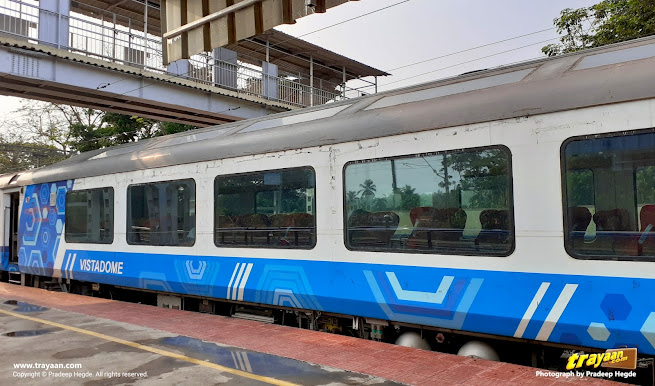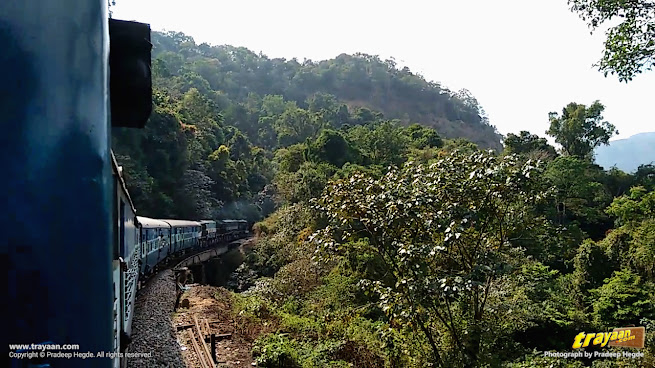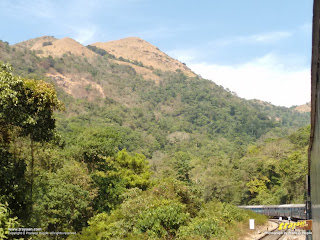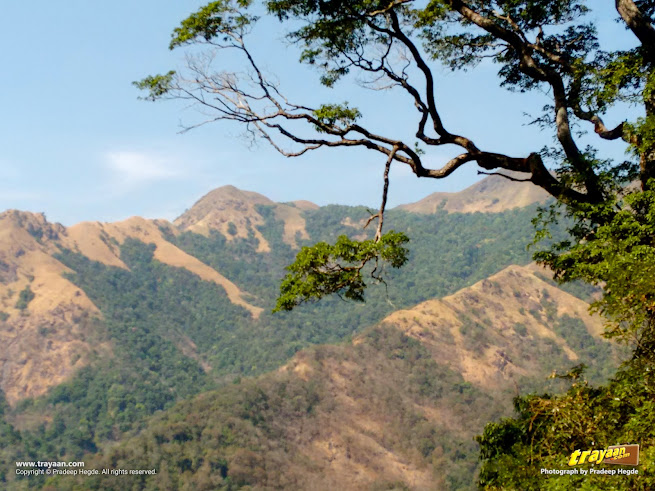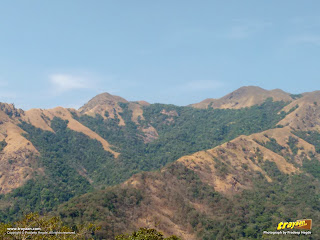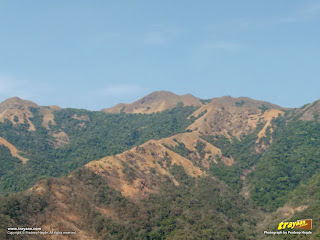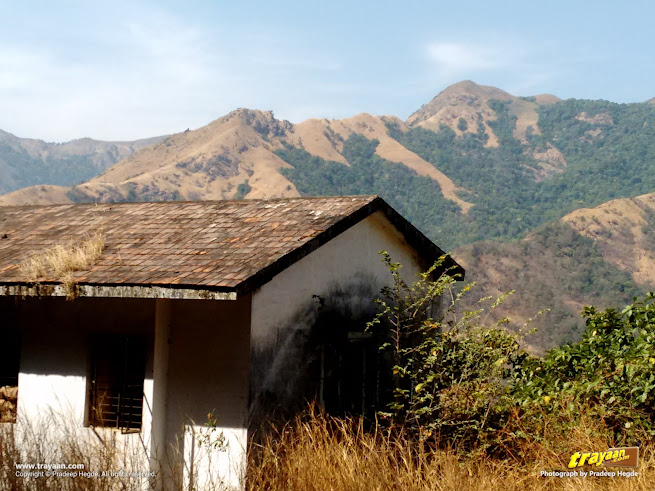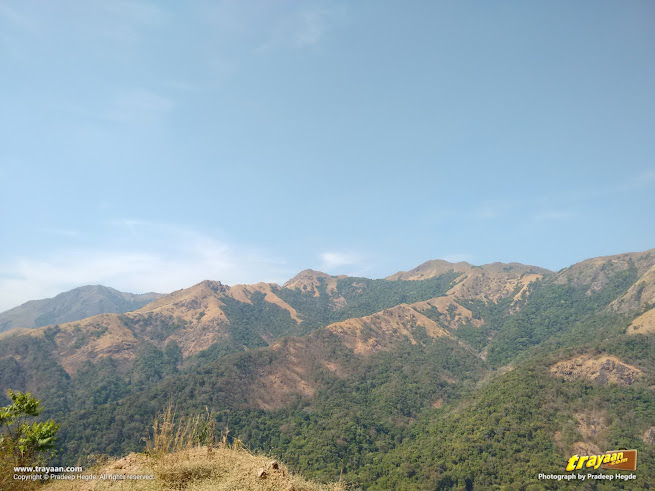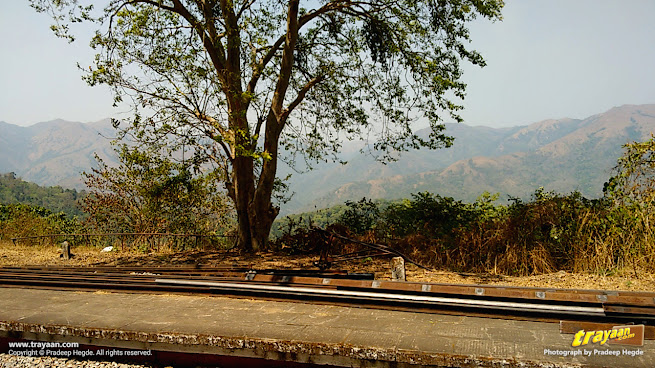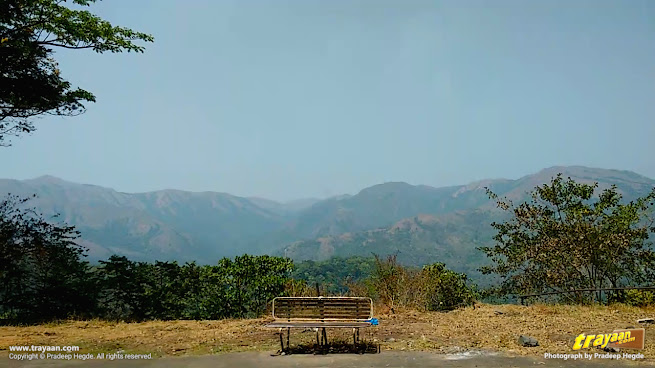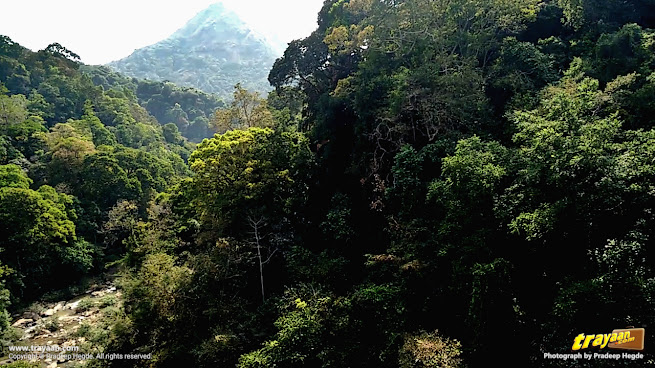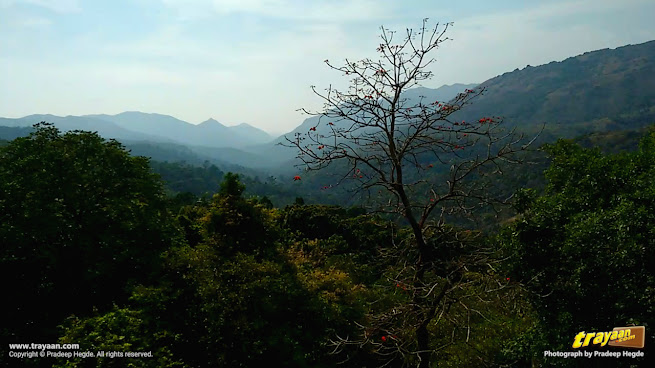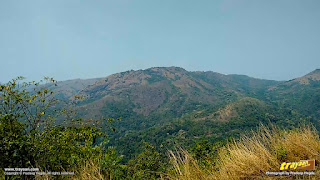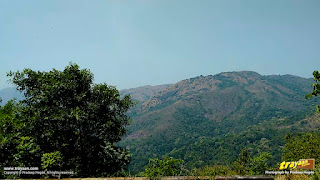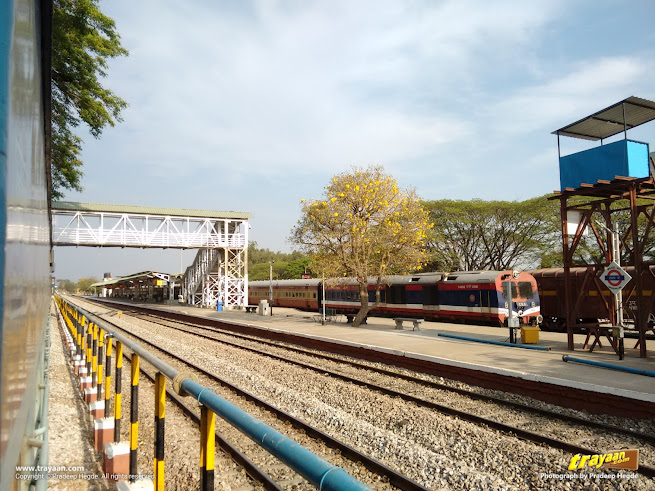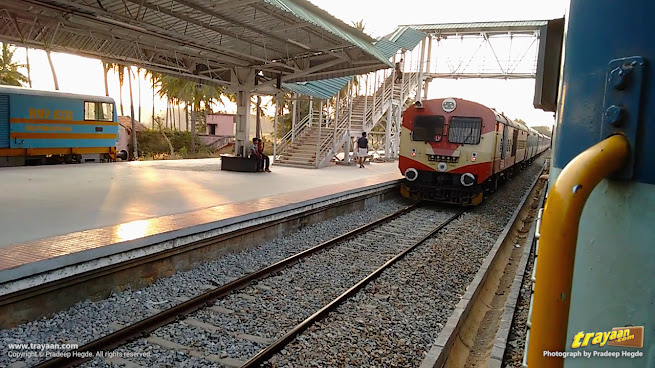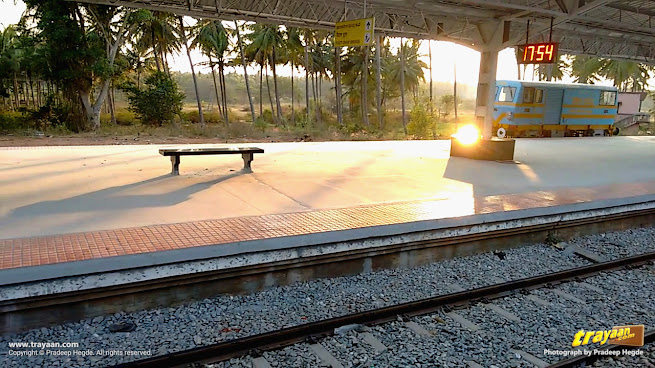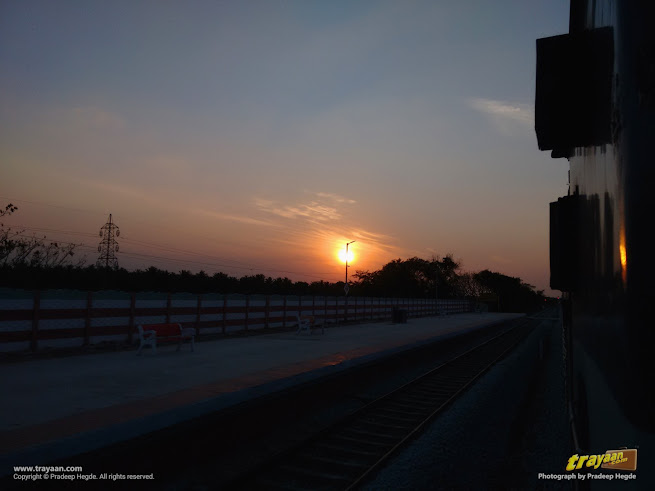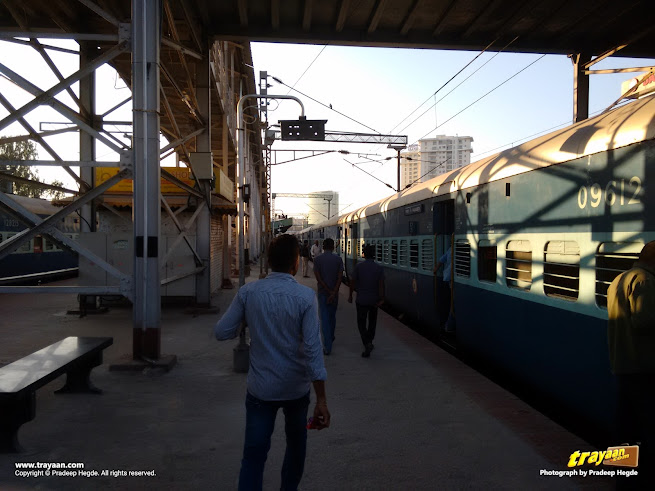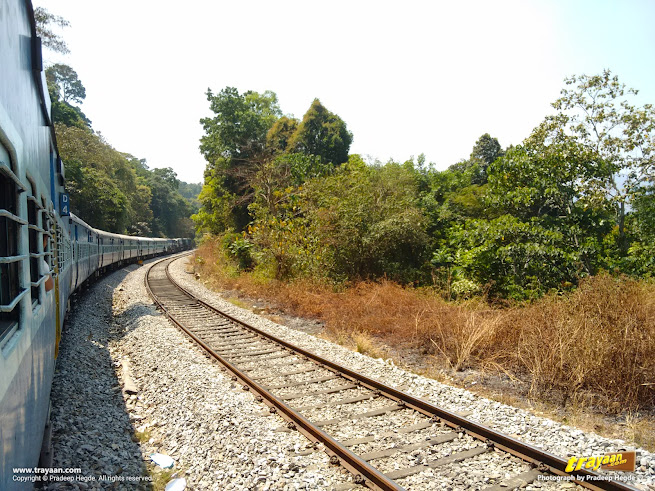A 413 kilometres railway journey between Bangalore and Mangalore through the splendidly scenic Sahyadri mountain range section in Karnataka.
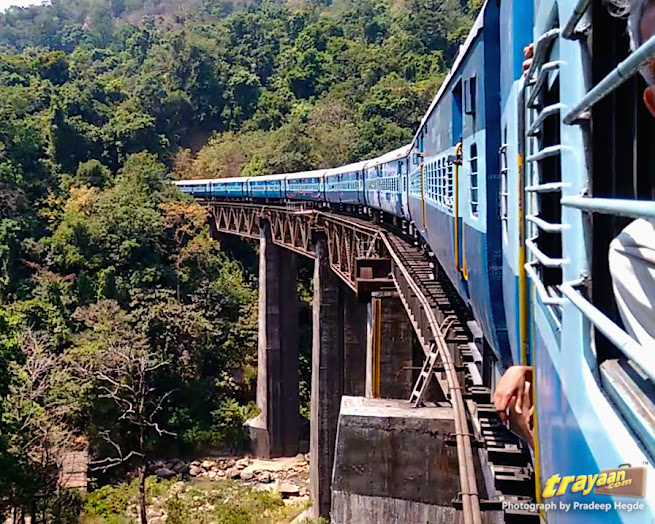
Here's an account of our two trips between Bengaluru and Mangaluru in a day train, with a video, pictures and details of both up and down journeys, information about this picturesque route, plus useful maps, helpful tips and more.
Video
The above video is made from some clips we took from our trips between Bengaluru and Mangaluru on a train along the railways that goes through the spectacular and scenic Sahyadri mountain range, which is also known as Western Ghats. And in our article below, you'll find more details about this scenic route, travel tips, and other related information.
| A video of these railway journeys | Train travels between Bengaluru and Mangaluru
- About these journeys
- Starting the journey from Mangaluru
- About Sahyadri / Western Ghats mountain range and the Deccan plateau
- Journey through the scenic Sahyadri - the Western Ghats
- Journey through Hassan - Shravanabelagola - Nelamangala section
| A brief history of Bangalore-Mangalore railway line
- The metre gauge line and the broad gauge after it
- The very delayed gauge conversion and the 14-year-long wait
| Tips for Travellers
About the video and article
The above video is made from a series of clips we took during two journeys between Bengaluru (Karnataka’s state capital city) and Mangaluru (Karnataka’s major port city). First part of the video is while moving from Bengaluru to Mangaluru and the other part is the journey from Mangaluru to Bengaluru.
These journeys were between Mangaluru Junction (MAJN) and Yeswantpur Junction (YPR) (a station in Bengaluru), where each journey had covered a distance of 413 kilometres in about 9 hours and 30 minutes. The train's speed is limited due to the Western Ghat section where it has to move slowly and it moves faster elsewhere.
The clips in these videos and most of the pictures are from our journeys during late February and early March of 2018. This is why in them you’ll see the older blue themed engines and ICF Coaches of Indian Railways which were running on this route at that time.
These days, modern LHB Coaches run on this railway line, and some trains in this route also have Vistadome tourist coaches. So obviously, you'll get a better view than what we got during these journeys.
I thought these video clips and pictures were lost forever but they were fortunately recovered recently from an old dysfunctional phone on which they were recorded. So, finally we can add this one to our list of travels and journeys here.

The clips in the video were taken through a fairly simple phone by today’s standards, so the video quality may not always be top-notch despite it being released in a HD format. Also, the phone had caused issues while recording videos and capturing pictures during movement, which is why you may notice few glitches or poorer resolution in some of them.
In case you didn’t know, Bangalore was officially renamed as Bengaluru and Mangalore officially as Mangaluru, discontinuing their previous anglicised names. I've mostly used the current official names in this article, except in cases while mentioning these places in a historical context.
Train travel between Mangaluru and Bengaluru
About these journeys
Here's a brief account of our Railway Journeys between Mangaluru and Bengaluru through the marvellous Western Ghats, along Subramanya and Shiradi Ghats sections in Dakshina Kannada and Hassan districts of Karnataka. This railway line offers some of the best scenes of the scenic mountains and hills of this region of the great Sahyadri range.
It was during late February and early March of 2018 when we made these travels along this route, and it was almost a year since Bengaluru - Mangaluru trains had begun moving through this new Hassan-Shravanabelagola-Nelamangala railway line that shortened the journey time by about an hour than the older Hassan-Arasikere-Tumakuru-Nelamangala route.
The famed hills of Shravanabelagola, Chandragiri and Vindhyagiri (which has the tallest Shri Bahubali Gommateshwara monolith), are seen at a distance while travelling through this railway route, and the day trains we travelled in between Bengaluru and Mangaluru, was aptly called the Gomteshwara Express, which commemorates the Jain deity.
We travelled between Bengaluru and Mangaluru in both up and down directions in the Gomateshwara Express which took around nine and a half hours to reach the destination in either case.
Starting the train journey from Mangaluru
While our video shows Bengaluru to Mangaluru journey first, in this article I'm considering our up journey as the one from Mangaluru to Bengaluru where we move up the ghats and the down journey as the one from Bengaluru to Mangaluru where we move downhill through the ghats.
Beginning from Mangaluru Junction (MAJN) in Karnataka's major coastal city (with most visited beaches of Karnataka) around 11:30 in the morning, our train had official stops at the following railway stations : Bantawala (near B.C. Road/Panemangalore), Kabaka-Puttur (at Kabaka, near Puttur), Subrahmanya Road (near the road to Kukke Subramanya, a popular Hindu piligrimage site by the Western Ghats), Sakleshpur (a popular a hill station situated amongst the Western Ghats), Hassan Junction (Haasana is close to great Hoysala world heritage sites), Channarayapatna, Shravanabelagola (Jain heritage and pilgrimage centre with tallest Gomateshwara monolith and Jain pilgrimage centre), B.G. Nagar, Yediyuru, Kunigal, Nelamangala, Chikka Banavara, and finally Yeswanthpur Junction in Bengaluru. The train also stopped in other places for either railway crossings or waiting for signal clearance.
Other day trains going through this Sahyadri section line will also have similar stops at above railway stations. There are many visit-worthy places close to the stations along this way, so you could also plan a trip between any of them on the day trains on this route while enjoying the splendid Sahyadri or Western Ghats as an additional value.
You can find more details about some attractions nearby railway stations on this route in our tips for travellers section below.

This is one of the two railway bridges across River Netravathi in Coastal Karnataka, near Mangaluru. The other one, which is even longer, you'll come across while going from Mangaluru towards Kerala.
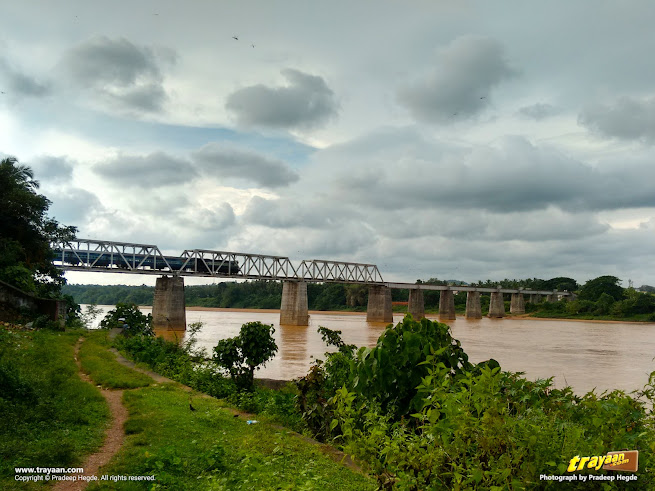
The bridge across River Netravathi near B.C.Road/Panemangalore, which you cross just before you reach Bantawala railway station, is one of the significant bridges in the South Western Railway (SWR) division. It has four spans of open web girders and then eight spans without it. It is the longest bridge in the Mysuru Division of SWR. This bridge was constructed back in 1977 when the metre gauge line was laid.[1]
Apart from between Bangalore and Mangalore, back in the 1990's, we had gone on a trip to the heritage sites of Belur and Halebeedu near Hassan, which was back in the days of metre gauge train that used to run through this Western Ghats section. We had also gone from Mangalore to Mysore by the metre gauge train through this route, as it also has to go via Hassan junction. More about that later below. Okay, that said, now let's go back to the Western Ghats.
About the Western Ghats mountain range and the Deccan plateau
Older than the Himalaya mountains, the Sahyadri mountain range, which are also called the Western Ghats, runs along almost parallel to India's western coast for about 1,600 kilometres (990 miles) while being approximately 30-50 km inland. [2]

They span an area of 1,40,000 sq.kilometres (62,000 sq miles), and go through the states of Gujarat, Maharashtra, Goa, Karnataka, Kerala and Tamil Nadu. It was designated as a UNESCO World Heritage Site in 2012 and is recognised as one of the world’s eight ‘hottest hot spots’ of biological diversity. [2]
The high rising Western Ghats block the monsoon clouds and cause them to pile up as they move upwards, causing the most spectacular rain and clouds in this region. They rise abruptly from the plain along the western coastal side of India, but the slopes on their eastern sides, that is, on the sides of the Deccan plateau, are much more gentle. [3][4]
The Deccan plateau is mainly between 1,000 and 2,500 feet (300 to 750 metres) and it slopes generally eastward. The word Deccan comes from the Sanskrit word dakshina meaning South. [4][5].
In case of the places we went through in these journeys, Mangaluru is on the coastal plain closer to the mean sea level, while Sakleshpur lies on the eastern side of Western Ghats and western side of Deccan Plateau, and Hassan and rest of stations till Bengaluru are all on the Deccan plateau.
Journey through scenic Sahyadri - the Western Ghats
The World Heritage Sahyadri or the Western Ghats along this railway route comes between the railway stations Subrahmanya Road and Sakleshpur.
Indian Railways route through Western Ghats
The more mountainous region in this section lies around 3 to 4 kilometres after Subrahmanya Road and about until Donigal near Saklespur. Along this stretch, the train moves slowly along a very curvy route by the mountainsides, through the mountains, and between them on high rising bridges.
Subrahmanya Road is a railway station near to the road leading to Shri Kukke Subramanya temple, a popular Hindu pilgrimage site.
The section called Shiradi Ghat begins after Gundya. It is called so because of the place called Shiradi which lies near Gundya junction of national highway NH75 and the road to Kukke Subrahmanya. Shiradi lies just by the Western Ghats where the National Highway between Mangaluru and Bengaluru, NH75 (old number 48) passes through, and this highway is popularly referred to as the Shiradi Ghat road. So, sometimes you may hear people referring to this scenic Sahyadri railway route as Shiradi Ghats railway line or even as Subramanya Ghats railway line, as it passes by these regions.
As you can see from my map above, a stream flows in the valley between the mountains in this section. This river is called Kempu Holé (meaning "Red River" or "Red Stream" in Kannada). The Bengaluru-Mangaluru national highway NH75 runs close on one side of this stream down in the valley, while the railways run high on the mountainsides on the other side, as you can see from the map.
At Subrahmanya Rd. station, additional locomotives (that is, railway engines) are added to the train as it needs more power to climb upwards through these Western Ghats. Additional engines are added at the rear end which help push the train while the engines in the front pull it, forming a push-pull action that moves the train forward as it keeps moving upwards through the ghats. The rear engines can be seen in some parts of our video.
The railway begins climbing up along the mountainsides a while after Subramanya Road railway station. You can see from the above map where the railway route begins to curve too much and starts going along the mountainsides, gradually climbing upwards and upwards.
There are some small railway stations over the mountains along the Western Ghats here but the trains don't have official stops at any of them. However, it may stop there waiting for a signal clearance or in case of a railway crossing.

We had stopped at Shiribagilu, which is the first station we get on the mountains while coming up from Subramanya Rd. We had stopped for a railway crossing here, where the day train Gomteshwara Express which was coming from Bengaluru to Mangaluru crossed us (as seen in our above video).
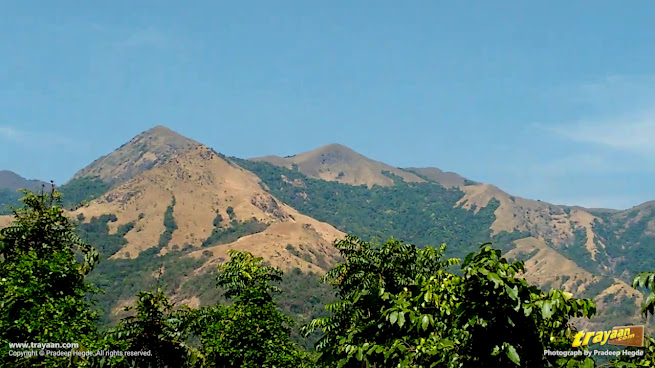
These mountain chains may look like small hills to you in these photographs and in the stills from the video, but don't get fooled by that. They look so only because by now the train itself is moving very high above the mountainsides running opposite to those mountains you see in the background.
These are actually very high rising mountains of Sahyadri / Western Ghats. The Shiradi Ghat National Highway runs beside the river/stream deep down in the valley between these two mountain chains. You can get a clearer idea from a top-view in our map above.

There will be additional locomotives even while coming down from the ghats, that is, while crossing these ghats when you're coming from Bengaluru to Mangaluru. You can see this in our video footage where the additional engines are seen during the Bengaluru-Mangaluru part or at the railway crossing scene at Shiribagilu where Bengaluru-Mangaluru Gomteshwara Express crosses our waiting train. But instead of being at the rear end while moving up the ghats, all three engines will be in the front end of the train while coming down the ghats.
It is not like a roller coaster ride, don't expect that while you're inside the moving train, as you won't realise the upwards or downwards movement as the inclines don't steep upwards or downwards at once, but gradually, as the train moves slowly through a very curvy route.
Due to high number of curves in this ghat section between Subramanya Rd. and Sakleshpur, the train has to move quite slowly in this section with an average speed of 25 kilometres per hour. The maximum speed allowed for a train is limited due to curves and elevations will further slow it down a bit. And sharper curves and elevations only mean more restrictions on allowed speed. Elsewhere, the train moves faster, but in these ghat sections it has to move slowly.
After coming close to Gundya, the railway route moves somewhat closer to the national highway. As you can see from my map above, when it comes closer to the national highway at Gundya, it's already at quite a height on the mountainsides.


In our video above, and in the pictures here, you can see the kind of views you get along this splendid western ghats section in areas where the train passes by Shiribagilu, Yedakumari, Kadagaravalli stations, which all lie high on the mountainsides of Sahyadri, and further till Donigal.

This Shiradi Ghats section or the section between Shiribagilu and Donigal especially offers some spectatcular views of Sayadri while moving through the train.
The scenery at Yedakumari railway station itself is spectacular. It sure looks alluring, but unfortunately the trains don't have any official stops here. It may slow down sometimes or stop momentarily for a signal or something. So, do not get down the train at any place or railway stations where there are no official stops. This station's name during the earlier metre gauge era was spelled as Yedakumeri in English.
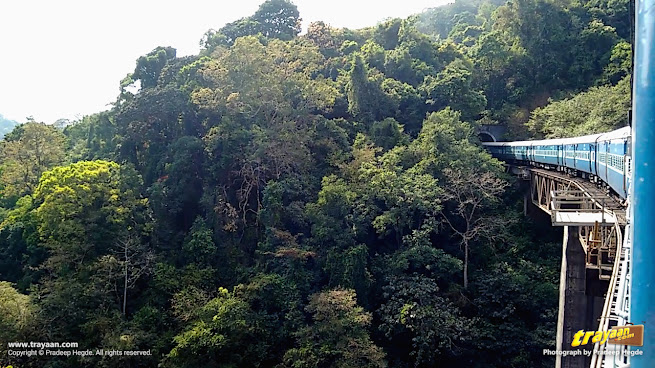
Our video covers this high rising curvy bridge in the above picture on both ways of the journeys. It appears briefly at the intro of our video and it is fully featured in it later on. The train exits a tunnel to cross this high bridge over a gap or small valley between the two mountains, where a small stream or rivulet flows down below. And soon after the bridge, it moves into another tunnel through the mountain on the other side of the bridge.
A small stream flows below, and in the middle of the background you see a sharp-peaked mountain (see below picture). Our video features crossing this bridge twice, once during Bengaluru-Mangaluru part and later on during Mangaluru-Bengaluru part. But I'll have to say that other people have taken better quality videos in this section which you can find on YouTube. See them to get an even better picture, or the best way is to travel this way yourself!
The peak seen in above picture is the mountain peak of Yedakumari, and the above bridge on the stream you just saw is between Yedakumari and Kadagaravalli stations, but more closer to Kadagaravalli station. It is marked on the above map as "Yedakumeri railway tunnel view point".
The mountaintops seen while passing along this railway section appear to be somewhat closer to your elevation as you are moving high above the mountainsides. In comparison, if you look at these mountaintops from anywhere below in the valley, they'll appear in a different way .

Going through this very scenic stretch, our train moved slowly through a very curvy route along the mountainsides and crossed many mountains through several tunnels and bridges.
There is a ruling gradient of 1 in 50 in this section between Subrahmanya Road and Sakleshpur railway stations, that is, for every 50 metres you travel upwards, your elevation rises up by 1 metre while going from Mangaluru to Bengaluru, and that elevation lowers at the same rate while coming in the opposite direction. A distance of 42.45 kilometres in this 55 km stretch has this 1 in 50 grade.[6]

This is a very scenic stretch but you have to keep an eye out for it. It is easier done, as the train has to move slowly along this stretch due to the steeper elevations and several sharper curves than ordinary routes.
At places, your views may be blocked by trees, tunnels, rocks, or other elevated areas through which the railway line is cut through, but you will nonetheless find several places where you can see and enjoy a great view of this marvellous mountain range of India from its great heights.
Along this railway section, there are totally 58 tunnels which I counted (and it is correct); and also as per Hassan Mangalore Rail Development Company Limited (HMRDC) data, the longest tunnel is No. 11 which is 575 metres long. [6]
The tunnels in this route are all numbered starting from Hassan or Bengaluru side, that is, the tunnel numbers go from 1 to 58 while going from Bengaluru to Mangaluru and go from 58 to 1 while going from Mangaluru to Bengaluru. All the tunnels in this entire route lie in this ghat section between Sakaleshpur and Subramanya Road railway stations.
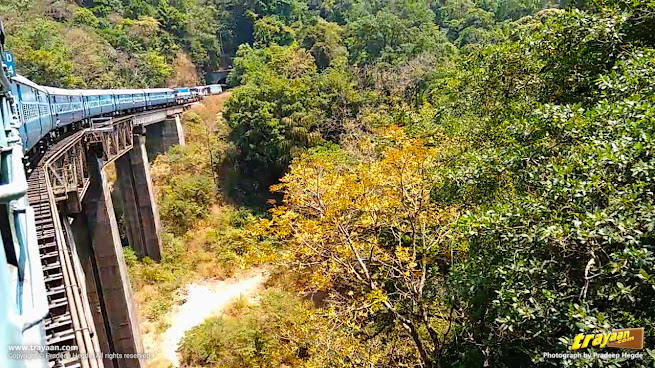
In this section there are totally 241 bridges, where 170 are major and 71 are minor, with the tallest being bridge No. 208. [6]
The length of this railway section between Sakaleshpur and Subramanya Road is 55.26 kilometres. And out of these 55.26 kilometers, 34.97 kilometres are curved tracks while 20.29 kilometres is straight tracks. [6]
From the Section Elevation data for railway stations, Hassan is at 900 metres above the Mean Sea Level, Sakleshpur at 899.72 metres, Subrahmanya Road at 113 metres, and Mangalore at 9.5 metres. [6]
You can see from above data that Hassan and Sakaleshpur, both on the high plateau, are almost at a similar level of around 900 metres from mean sea level while Subramanya Rd. station, which is on the other side of Western Ghats, is much lower at 113 metres. And Mangaluru station is even lower at only 9.5 metres from the mean sea level.
As you can clearly see, the highest difference in elevation of about 787 metres is between Sakleshpur and Subramanya Road stations, where the Western Ghats section runs through! This is how much the train has to gradually "climb" up or down between these two stations on two sides of the Sahyadri.
The small railway stations over at the great heights of Shiradi Ghats give you spectacular views of the splendid Sahyadri near them, but unfortunately the trains do not have any official stops in those small stations. There are also a couple of places along this section where from your train you can spot the national highway running way below in the valley between the mountains, if you try to look for it.
Most scenery along this Western Ghats section will be on the left side while going from Mangaluru to Bengaluru, and on the right while going from Bengaluru to Mangaluru.

If you’re crossing the Western Ghats here through the Shiradi Ghats National Highway (NH75) between Bengaluru and Mangaluru, then at a couple of spots by that highway, you can spot a place high above in the mountains where you can notice a small railway bridge which is along this very railway route, and if your timing is lucky, you may even spot a train passing through this route high above on the mountains.
Crossing these spectacular Western Ghats no faster than an average of 25-30 kilometres per hour, we finally reached Sakaleshpur. Here, the rear engine that helped us move up through this Sahyadri ghat section, was detached. From here onwards the train moved faster, towards Hassan.
Journey through Nelamangala - Shravanabelagola - Hassan section

After Hassan, it is all Deccan plateau and it is mostly flat terrain where the train moves faster. It is also scenic in its own way, with greenery and agricultural fields seen mostly on both sides.
In some stretches along Hassan - Shravanabelagola - Nelamangala, you can also see the National Highway (NH75) moving close on a side of your train's tracks.
Starting around 11:30 in the morning from Mangaluru Junction, we were in Channarayapatna railway station by evening, and began moving ahead from there at 17:54, which is 05:54 PM, with the evening sun shining off the platform.

Our train passed through several beautiful fields and by at least one beautiful lake, along this way, and reached Shravanabelagola station just before sunset.
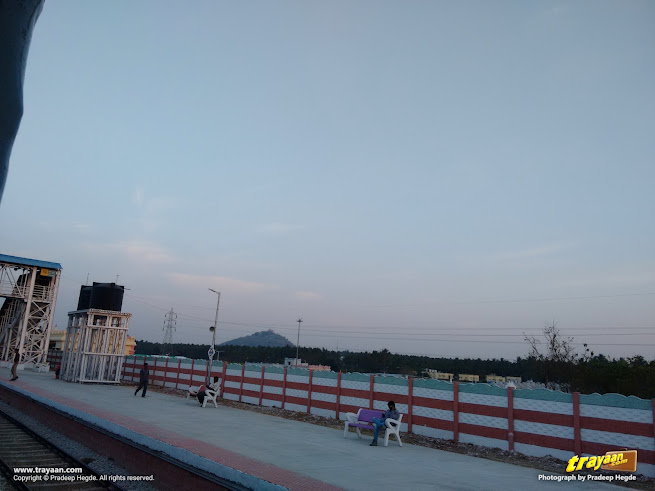
As mentioned before and as seen in the video, the famed rocky hills of the famed Jain heritage centre Shravanabelagola, which are : Chandragiri and Vindhyagiri, can be seen at a distance while travelling in the train. While going from Mangaluru to Bengaluru, these hills are seen on the right side and while moving from Bengaluru to Mangaluru they're on the left.
The history of Chandragiri hill goes back to at least 300 BCE when Acharya Bhadrabahu and Chandragupta Maurya visited this place,[7] and it houses several Jain Basadis.

Vindhyagiri is the huge rocky hill which has the tallest Shri Bahubali Gommateshwara monolith above it, along with other Jain temples and shrines.
Finally, the train reaches Nelamangala where it merges with the Bengaluru - Tumakuru line and then reaches Yeswantpur railway station.
Note that these were day trains that we travelled in this way. There are overnight trains which also travel by this way between Mangaluru and Bengaluru. However, if your take a night train between Mangaluru and Bengaluru, you will miss these splendidly scenic Western Ghats section as you'll pass through them during night time.
Overall, it was a very pleasant and enjoyable journey. But it was hot and humid as summer was beginning by then.
Our return journey from Bengaluru to Mangaluru was very similar, hot and humid. Only thing is that unlike the train from Mangaluru Junction which left at around 11:30 in the morning, the train from Yesvantpur Junction left at around 7:15 in the morning. The day train timings are quite similar now in 2024 but for all current timings you should check the official Indian Railways IRCTC website.

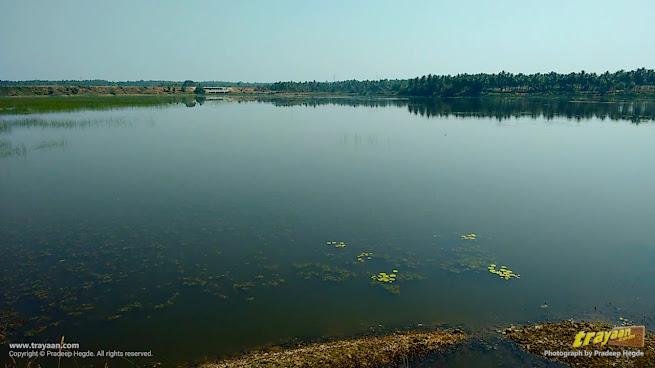
And then it was the same beautiful scenery along the way, as you can see in our video, a hot and humid bright and sunny day all along this trip, as we reached Mangaluru junction around 16:30 or 16:45, that is around 4:30 - 4:45 PM in the evening. The trains had clean and well maintained bio-toilets.
Well, that's all about our trips through this spectacularly scenic route. But wait, that's not all!
Let us see below some brief history of the railway lines through these splendid Western Ghats, and after that, we have some helpful tips for travellers who want to travel on this scenic route.
Brief History About this Bangalore – Mangalore Railway route
The metre gauge line and the broad gauge after it
A metre gauge railway route from Bangalore to Hassan via Arsikere existed back in the British colonial era itself [8], but there was no direct railway line between Mangalore and Hassan, through this spectacular Western Ghats section which is a very tough mountainous range with high elevations and dense forests.


This metre-gauge line to connect Mangalore and Bangalore was planned in 1950's with work beginning in 1960's and completed in 1978 [9][13]. The metre-gauge line between Mangalore and Hassan was opened gradually between 1976 and 1977, and passenger trains began passing through here only since 20th of May 1979. [10]
I had travelled through this metre-gauge railway line section between Mangalore and Hassan on multiple occasions in my younger days, while travelling between Mangalore to Bangalore, Mysore, or Hassan.
The railway routes from Mangalore to Bangalore, back during the meter gauge era (and also after completion of conversion to broad gauge later on) was primarily through two ways :
- Mangalore (known today as Mangaluru Central) – Hassan – Arasikere – Bangalore (known today as KSR Bengaluru). A shorter railway route from Hassan to Bangalore via Shravanabelagola did not exist till early 2017.
- The other rail way between Mangalore and Bangalore was via Mysore (now Mysuru), that is, Mangalore – Hassan – Mysore – Bangalore. Some trains go along this route these days too. However, unlike before in the metre gauge era, trains between Mangaluru and Mysuru these days are only night trains.
In either case during the metre gauge era between Mangalore and Bangalore, all the meter gauge trains ran through this marvellous route through the Western Ghats between Mangalore and Hassan. From Hassan, we used to reach Bangalore through Arasikere and Tumkur route.
This railway route is nostalgic for those from Karnataka's coastal belt, especially to Mangaloreans. I still remember travelling in the meter gauge train to Bangalore during my childhood days and the train used to go till Arsikere Junction railway station and it used to get reversed there as it had to move towards the direction of Bangalore from there.
That is, if you were seated in a forward looking seat in Mangalore, you’d become a backwards looking seat after Arsikere Junction. And same reversal thing happened at Arsikere while coming back from Bangalore. Similarly, if you were going via Hassan - Mysore route, you'd get reversed at Hassan Junction itself. But from Hassan, you go straight ahead until Arasikere if you went that way to Bangalore.
The different sections between Bangalore and Mangalore got upgraded to the 5 feet 6 inch broad gauge in part by part over many years (we'll see more on that later below). Even after this line became fully broad gauge and broad gauge passenger trains started moving between Mangalore and Bangalore in December 2007, the trains still used to reach Bangalore via Arasikere - Tumkur route itself.
The new 167 kilometre railway line connecting Hassan and Nelamangala stations via Shravanabelagola through a shorter distance, was opened only in March 2017. [11]
The railway line through this Western Ghats section was a great feat of engineering as it created a railway through its tough and dangerous terrains by making a railway passing through and between several mountains.
It was indeed a mountainous task achieved and a colossal feat accomplished. Also, despite laying metre gauge tracks, the size of the tunnels and the base of the tracks were made considering a potential gauge conversion to broad gauge in the future.
Back in the days when this railway line was being planned, even though a broad gauge line was strongly suggested, only a metre gauge line was approved by the Indian Railways considering the infrastructure back then. Even then, the railways constructed the base and tunnels in the broad gauge standards itself to easily accommodate it in the future, while only the tracks laid were metre gauge. [12]
The highly delayed gauge conversion and the 14 year long wait
Gauge History : A summary of Passenger Trains between Bangalore and Mangalore
- Metre Gauge : From 1979 to 1995. (Metre gauge line was completed in 1978)
- No trains on this route (closed for gauge conversion) : 1995 to 2006. (Broad Gauge line completed in 2006 & goods/freight trains began running)
- Broad Gauge (night trains only) : 2007 onwards.
- Broad Gauge (day trains also) : 2009 onwards.
The metre gauge line began passenger trains in 1979 but it was shut down in 1995-96 [13] for gauge conversion to broad gauge and the tracks were removed part by part along this route.
That is, the metre gauge trains between Mangaluru and Bengaluru (as well as Mangaluru and Mysuru) ran for around 16-17 years along this scenic Sahyadri line until it was shut down for gauge conversion. The 236 kilometres long Arsikere-Hassan-Mangalore gauge conversion project was sanctioned back in 1994-95 [9], but while Arasikere to Hassan got completed quicker, the stretch between Hassan and Mangalore got very delayed.
As aforementioned, as the base and tunnels were already made to accommodate broad gauge, all they mainly had to do was to change the tracks from metre gauge to broad gauge. But boy, did that take long.
The full gauge conversion between Mangalore Junction (back then named as Kankanady) and Hassan Junction stations, which is totally 183 kilometres long, was completed only in 2006 by the HMRDC[14] (which was formed in 2003 to complete this incomplete gauge conversion project).[15]
Even though this metre gauge to broad gauge work was fully completed in May 2006[14], only goods trains were running through this way for over a year, and the first broad gauge direct passenger train between Bangalore and Mangalore through this route was finally begun only in December 2007.[16][17] (Note : Mangalore Junction was known as Kankanady railway station back then while Mangalore Central was known as Mangalore railway station).
That is, it took about 11 long years to complete gauge conversion from metre gauge to broad gauge and begin goods trains on this line (despite the base and tunnels of this metre gauge line were already made for broad gauge when it was first constructed) and it was 12 long years until direct passenger train between Karnataka's state capital and major port city was resumed.
But wait! That's not all. For you still couldn't see this section of splendid Sahyadris while travelling by railways yet. For it was only night trains which began running along this very scenic route in 2007[16][17], and both ways you passed this scenic Sahyadri section only during the night time! The first day train to run on this route began running only two years later in 2009.[16]
That is, Mangalore-Bangalore day train in this route resumed only after 14 long years since this route was shut down for gauge conversion. In short, in this pleasantly picturesque Sahyadri route, metre gauge passenger trains ran for about 16-17 years, then for aound 12 years there were no passenger trains; and after around 14 years, passenger day trains started running again. And right now in 2024, it has been 15 years since passenger day trains began running on this picturesque route again in day time.
Of course, within this period there were hikers who kept hiking to parts of these railway lines and scenic Sahyadri while it remained closed over the years for gauge conversion. But railway passengers got to travel through this spectacular Sahyadri section and view it too, only after 14 long years.
This gauge conversion project suffered from a lack of interest and budget allocations, especially for this section, according to various news reports. Even though Hassan-Sakaleshpur line was converted to broad gauge earlier in comparison, [13] it looks like things began moving ahead again only after 2003, which was the year this section became a part of the newly formed South Western Railways (SWR) division and HMRDC (Hassan Mangalore Rail Development Company Limited - A Joint Venture of Ministry of Railways & Govt. of Karnataka) was also setup in the same year.[15][18]. While other major stations in this section became a part of SWR, Mangaluru Junction and Mangaluru Central still remains a part of Southern Railways, as before.
Out of the 236 km Hassan - Mangalore route, gauge conversion for Hassan to Sakaleshpur section was completed earlier than the rest of the route. The remaining sections of Kankanadi to Kabaka-Puttur (44 km) was completed in 2003-2004. Kabaka-Puttur to Subramanya Road (42 km) was completed in 2005-2006. And finally the last remaining section, the one which crosses the Western Ghats, Sakleshpur- Subramanya Road (55 km) was completed in 2006-2007.[19]
Anyway, as the old saying goes, all's well that ends well. For these days you can travel through this splendid Sahyadri section not only by a regular broad gauge train but also in a splendid Vistadome tourist coach. And that's all for now, folks. Don't forget to join us next time on our next travel story. Here's wishing you a happy travelling!
Tips for travellers
Below are some useful tips for your railway journeys through this scenic route. You can find below the best times to travel and after that there's more tips for travellers.
The best times to travel
Please note that these best times reflect only the typical times which may be favourable based on the normally expected seasonal activities in this region.
Do keep in mind that weather can be unpredictable at times and there may be days where there are heavy rains or clear skies at any time or season irrespective of the usual seasonal expectations. So, to be really sure, you should always check the weather before travelling.
- During Winter or Summer : The best time to travel in this route is during winter (November to February), or better yet, after the monsoon rainy season has stopped (sometime around September to February). You can also go during summer around late February/early March to April/early May before the summer rain clouds begin in late May, that is, if you don't mind the summer heat.
- During winter and early summer, the skies will be clearer without much clouds and you can watch great scenery with spectacular backdrop of Sahyadri mountain range.
- Travelling this way right after the monsoons clouds have receded, would be a great time as the greenery would be higher at this time. Monsoon rains typically decrease and withdraw during September or sometimes during early October in case of a late withdrawal.
- During Monsoons : This is the South-West Monsoons that rain in this region typically between June to September, which are sometimes delayed (to early October) or advanced (from late May) by some days or weeks. Travelling through this route during monsoon or rainy season has its own charm as there will be great greenery and the undeniable bliss of the rains and water falling from mountains and the monsoon clouds clinging to these mountains, so go ahead if you want to experience that, but however, there are two things to remember during monsoons.
- During the monsoons or rainy season, the ghat sections are more prone to nature's fury, such as, landslides or heavy rains due to which train services along this route may be cancelled or unavailable during such times. So, you have to take this into consideration if you're booking beforehand or planning to travel this way during the rainy season.
- The other thing during monsoons is that you may not be able to see as much scenery along the Western Ghats here, and a lot of great views may be blocked by thick rainy clouds. That is, you may not be able to see much views of mountains or valleys during monsoon, depending upon the clouds and they may block your views. After all, not to forget that it is these Western Ghats that block the monsoon clouds from passing over to the Deccan plateau and bring rains to the coastal regions.
More Tips for travellers
- If you want to see this part of the scenic Sahyadri, then take a day train that runs between Mangaluru and Bengaluru, or in general, any train that goes between Mangaluru and Hassan during daytime. Some day trains in this line are extended till Karwar.
- There are night trains in this route too. But if your take a train that goes overnight between Mangaluru and Bengaluru, then you will miss the most scenic part of this route which you'll be crossing during night time.
- Vistadome tourist coaches are also available in some day trains running along this route, and Vistadome is mainly built for better tourist sightseeing.
- These days you’ll find newer LHB coaches running along this line rather than the older ICF coaches that we had travelled in back in 2018. The newer LHB coaches which run along this route have bigger and better windows than the older ones, and will give you a better view compared to the older ICF coaches.
- While going from Mangaluru to Bengaluru, the best scenes along the Western Ghats section appear to the left side. That is, from Bengaluru to Mangaluru they're on the right.
- As the train timings, availability, and as well as routes and types of classes or coaches may be suject to change, we cannot give you such details here. Please view the official Indian Railways IRCTC website for current train timings, availability, and the types of coaches or classes available.
- On the IRCTC website, after searching for trains between Bengaluru and Mangaluru or any other start and end stations of your choice, in the displayed results on IRCTC, click on the Train Schedule link beside each train to see the timings of that train.
- On that page, note the arrival and departure times for the railway stations Sakleshpur and Subrahmanya Road to find out whether the train passes along the Western Ghats section during day or night.
- Mobile phone network coverage is very poor to none along most parts of the Western Ghat sections which come between Sakaleshpur and Subramanya Road. Which shouldn't really bother you, for it is better spending time enjoying the natural beauty of charming Western Ghats rather than gazing at your phone's screen all the while.
- There will be food sellers selling items like pulav, curd rice etc. (which we saw during our trip, and I don't know what all things are available in this route these days), but to be on the safer side, you can take some food parcel in case you my not like what you get along the way.
- Although trains between Mangaluru and Mysuru goes through this same Western Ghats route (as the only railway path between Mangaluru and Mysuru is through Hassan junction), unfortunately currently there is only a night train in this route that goes towards Mysuru. (However, during the metre gauge era, I had travelled in a day train between Mangalore and Mysore and it passes close to and crosses KRS dam backwaters, which was picturesque. However, there may be other trains between Hassan and Mysore that may pass that way during daytime, but as of now you can't club both Western Ghats and Mysuru during daytime in a single train.)
- Although there are multiple trains running between Mangaluru and Chennai and this route via Hassan-Shravanabelagola-Bengaluru would be a much shorter railway route (of about 780 kilometres) between the two cities (and which would've connected two major port cities of two states as well as connect two state capitals along this line), all trains currently running between Mangaluru and Chennai take a much longer of about 900 kilometres route through Shoranur Junction in Kerala. So far, not a single train between Mangaluru and Chennai goes via this Western Ghats route through either Hassan-Shravanabelagola-Bengaluru or even via Hassan-Mysuru-Bengaluru. If you're travelling between Mangaluru and Chennai and you want to cover this beautiful Sahyadri stretch by train alone, then you have to take two separate trains that end and begin at Bengaluru.
- If you're not satisfied with this Shiradi section of Western Ghats, there's even more Western Ghats along Mangaluru to Mumbai line of Konkan Railways. The section between Madgaon (in Goa) and Ratnagiri (in Maharashtra), which are between Goa and Mumbai, is the most scenic in that route. The other Western Ghat section worth crossing by railway near Goa is the one you get between Madgaon in Goa and Londa in Karnataka, where the train passes by the famous Doodhsagar waterfalls. In any case, if you intend to see the scenery, you have to choose a train that passes through those sections in day time.
- And last but never the least, do not litter! While you shouldn't be throwing anything out the window anywhere, do not ruin the pristine natural beauty of the Sahyadri. During train journeys there are always some people's hands you can see throwing something out through some window up ahead or behind. There will be dustbins in the coaches and that is where your trash should go, and not outside the window.
Some tourist attractions close to railway stations along this route
- Mangaluru and Coastal Karnataka offer many beaches and other heritage sites close by.
- Subrahmanya Road railway station is about 12 to 13 kilometres (around 20 minutes by vehicle) to Kukke Shri Subrahmanya Swami Temple, a popular pilgrimage site.
- Sakaleshpur is a popular hill station.
- Hassan Junction is about 40 kilometres (around an hour's drive away) to Belur, which has Hoysala World Heritage Site Shri Chennakeshava Temple.
- Hassan Junction is at about 32 kilometres (around a 50 minutes drive away) from Halebeedu, which has World Heritage site Hoysaleshwara Temple and more Hoysala era temples.
- Shravanabelagola has many ancient temples and this Jain heritage site has the tallest Shri Bahubali Gommateshwara monolith above Vindhyagiri. These are just around 3 kilometres away from the railway station, that is about 5 minutes in a vehicle from the railway station.
Footnotes
- Railway coaches or carriages are what we locally call as “bogies”. ICF coaches are passenger coaches which were used in trains in most railway lines across India. They're currently seen in light yellow coloured theme with a brown coloured line below the windows, or their earlier blue themed colouring (as seen in our above video), or their even earlier typical colour scheme of fully Indianred or brick red colouring.
- ICF stands for Integral Coach Factory, and Indian Railways has been replacing the older ICF coaches with the newer LHB Coaches as they provide more stability at higher speeds and come with more features.[20]
- Linke Hofmann Busch (LHB) coach is a passenger coach of Indian Railways that is developed by Linke-Hofmann-Busch of Germany, and are manufactured at Indian Railways units across India.[20]
- These days you’ll see many trains, on this route as well as in other routes, running with LHB coaches rather than the older ICF coaches, as Indian Railways is gradually phasing out older ICF by replacing them with the newer and better LHB.[20]
- From 2015 to February 2024, about 23,000 conventional ICF Coaches were replaced by LHB Coaches.[21]
References
- Brigde - Significant Bridges, South Western Railway. Retrieved on Friday, January 12, 2024 17:30 IST.
- Western Ghats - UNESCO World Heritage Centre. Date of Inscription: 2012, retrieved on Thursday, January 11, 2024 16:00 IST.
- Indian monsoon - Encyclopedia Britannica. Last Updated: Nov 22, 2023, retrieved on Friday, January 12, 2024 18:00 IST.
- Deccan plateau, India - Encyclopedia Britannica. Last Updated: Apr 19, 2023, retrieved on Thursday, January 11, 2024 16:00 IST.
- India - Deccan, Plateau, Monsoon - Encyclopedia Britannica. Last Updated Apr 19, 2023, retrieved on Thursday, January 11, 2024 16:00 IST.
- Salient features of the section - Hassan Mangalore Rail Development Company Limited, retrieved on Thursday, January 11, 2024 16:00 IST.
- Inscriptions at Sravana Belgola: a chief seat of the Jains, (Archaeological Survey of Mysore), by Rice, B. Lewis (1889). Bangalore : Mysore Govt. Central Press.
- Administration Report on the Railways in India – corrected up to 31st March 1918, Superintendent of Government Printing, Calcutta; page 195; Retrieved January 12, 2024.
- News headlines - Daijiworld Sat, Jan 28 2006 12:00:00 AM.
- Indian Railways History: 1970 - 1994 - IRFCA - The Indian Railways Fan Club, retrieved on Thursday, January 11, 2024 16:00 IST.
- After 21 years, shorter rail route finally connects Bengaluru, Hassan - By Express News Service, The New Indian Express, Published: 26th March 2017 04:14 PM, Last Updated: 27th March 2017 05:38 AM.
- Call to speed up Mangalore-Hassan line conversion - TNN, The Times of India, Nov 28, 2001, 22:54 IST.
- Six years on, Mangalore-Hassan line hangs fire - Stanley G. Pinto, The Times of India, Feb 25, 2002, 23:11 IST.
- Project Implementation - Hassan Mangalore Rail Development Company Limited, retrieved on Thursday, January 11, 2024 16:00 IST.
- The Beginning - Hassan Mangalore Rail Development Company Limited, retrieved on Thursday, January 11, 2024 16:30 IST.
- Indian Railways History: 2005 - 2014 - IRFCA - The Indian Railways Fan Club, retrieved on Thursday, January 12, 2024 18:40 IST.
- Mangalore-Bangalore train service from saturday - PTI, The Economic Times, Last Updated: Dec 07, 2007, 05:29:00 PM IST.
- About Us - South Western Railways, retrieved on Thursday, January 11, 2024 16:00 IST.
- Milestones - South Western Railways, retrieved on Thursday, January 11, 2024 16:00 IST.
- Upgradation of Coaches - Ministry of Railways, Press Information Bureau, Govt. of India. Posted On: 24 MAR 2021 3:58PM by PIB Delhi.
- About 23000 Conventional Coaches Replaced By LHB Coaches Since 2015 - Ministry of Railways, Press Information Bureau, Govt. of India. Posted On: 02 FEB 2024 4:55PM by PIB Delhi

